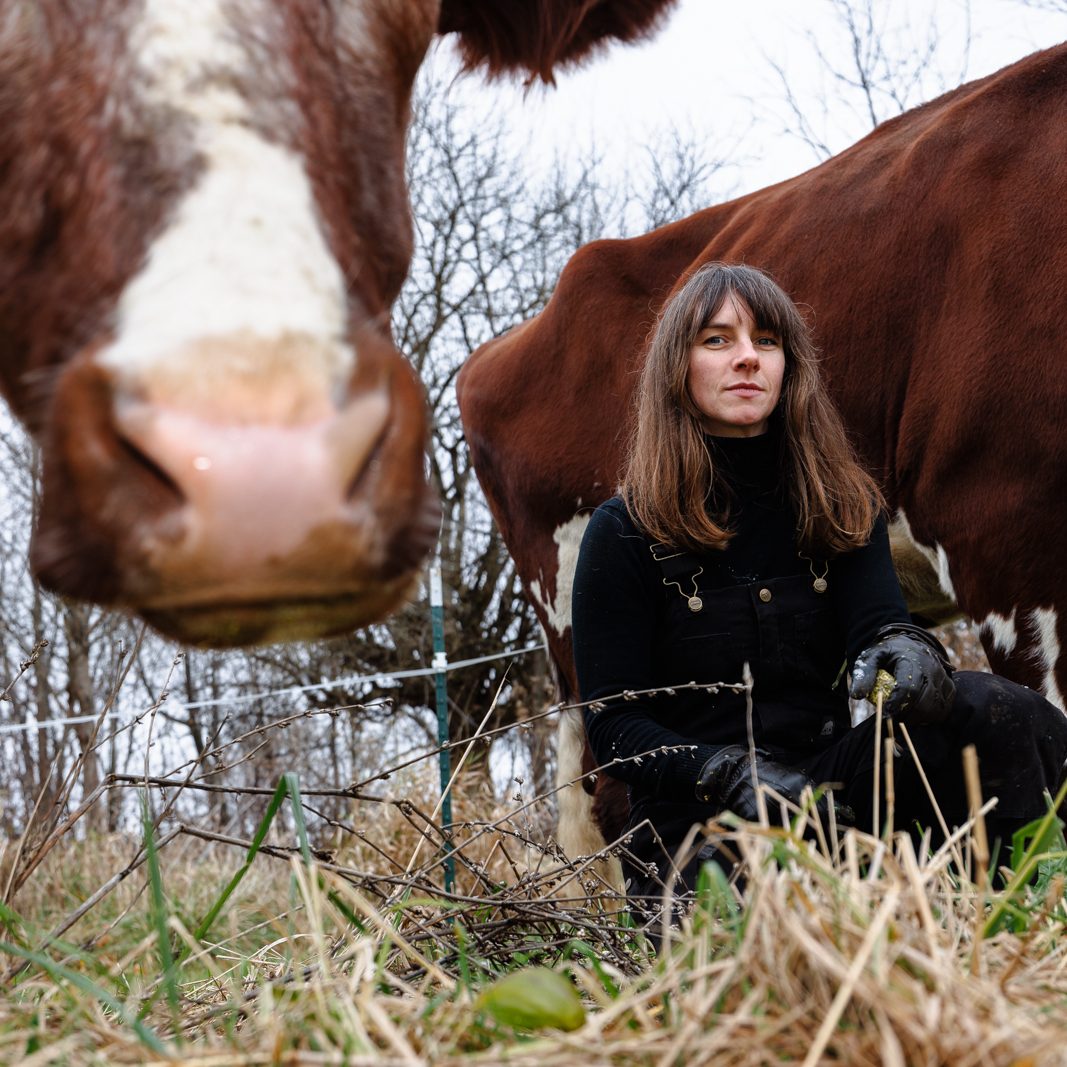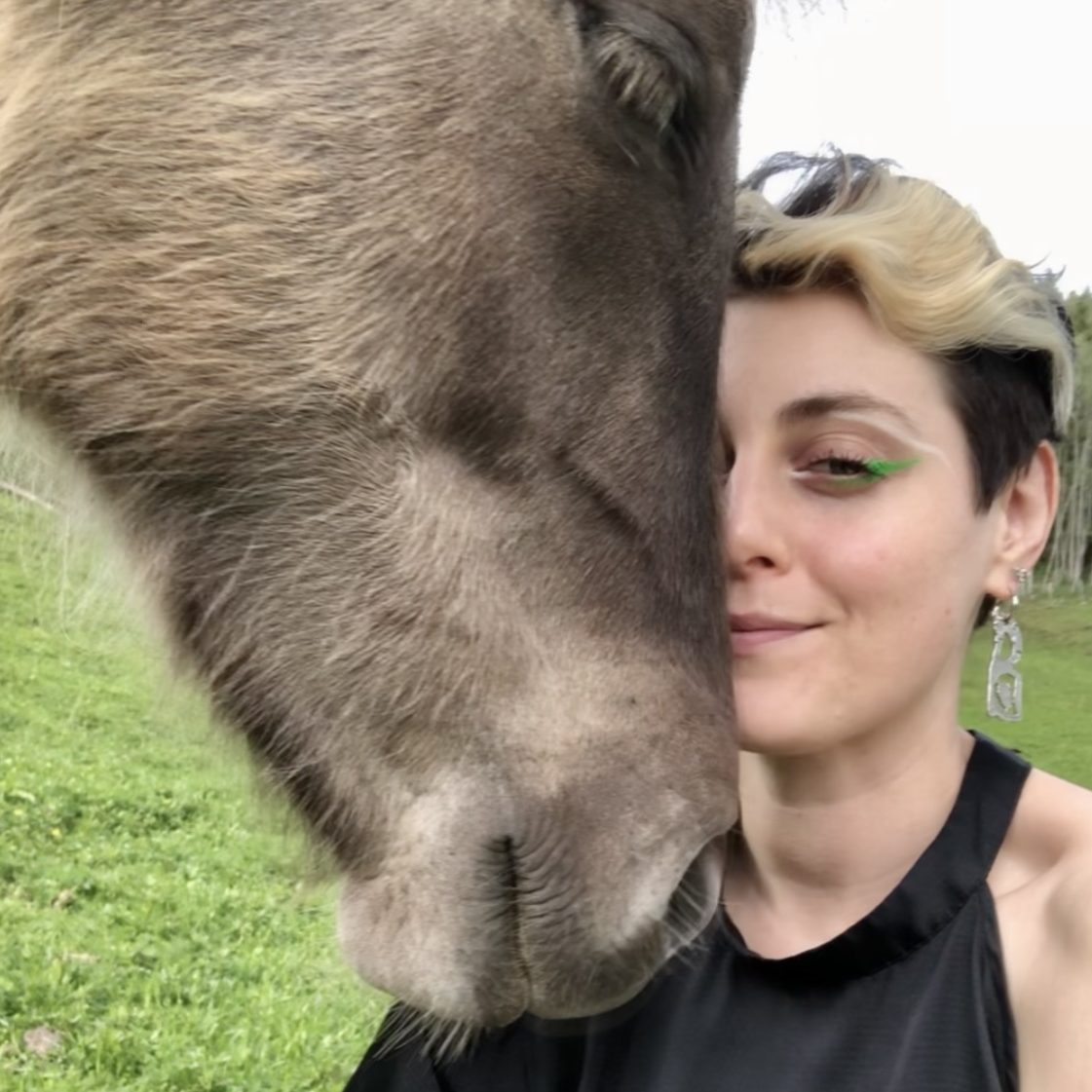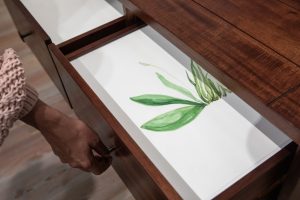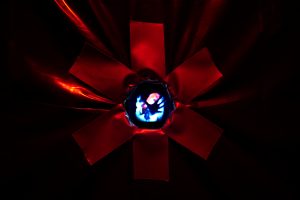This recording occurred 8:49 am on Tuesday, October 22, 2024, at Bloomington, Normal, Illinois, the land of Indigenous people who were forcibly removed and oppressed for centuries. Their struggle for survival and identity after dispossession and displacement marks their resilience. We acknowledge that the city of Bloomington sits on the lands that are home to the Illini, Peoria, and Myamia and later, due to Colonial encroachment, genocide, and displacement, to the Fox, Potawatomi, Sauk, Shawnee, Ioway, Mascouten, Wea, and Kickapoo Nations. We express honor to those excluded due to error and historical inaccuracy. I also want to acknowledge, as a land steward, I am a beneficiary of this displacement and genocide. The land I steward, where this interview takes place, was claimed by white people after the Indian Removal Act.
I acknowledge that Afro-descendant people were violently robbed of life, labor, land, safety, community, culture, and dignity during and after slavery, as well as those violently robbed of the same through hierarchies of sexuality, gender, race, language, and ability. These are and have been sustained by a range of power formations including the state, through which I am employed.
This interview with artist D Rosen discusses work in their exhibition VAMP, queerness in the more-than-human world, human fears and anxieties towards Bats, their place in a greater ecosystem, materiality, and the gallery’s function in considering nonhuman animals.
For the full-length interview visit this link.
Ruth Burke: Who are you and what do you do?
D Rosen: D Rosen. I’m an artist. I live on the lands of the Council of Three Fires in Chicago, Illinois. I’ve been living here on and off for the past 13 years while traveling for residencies throughout Europe. I have always, somewhat obsessively, focused on nonhuman animals in my life and practice.
Most of my direct work with nonhuman animals occurs through nomadic labor on different farms and sanctuaries throughout the United States and Norway. On breaks from normal tasks like barn cleaning or feeding, I drop in to provide additional care that isn’t otherwise available because the farmer is busy or at capacity. Sometimes that means providing enrichment or socialization. Then whatever ephemera comes out of those social interactions, is cast into a performative document often in recycled metal.
That’s one branch of my practice. Another interrelated branch is fostering discourse about the ways that the world is queer and trans as a way to celebrate the flourishing of queer ecologies in [a] multi-species world.
RB: Absolutely. I respect your long-standing commitment to animals. We need that ability to look, stay attuned, hear what they have to say, and receive what they can teach us, to learn who animals are on an individual and species level.
DR: I see a shared sensibility and respect in your practice. Commitment to interspecies attunement is crucial with whole ecologies and with each individual we’re working with on very specific levels. It’s like any friendship. If you don’t have sustained commitment, and [don’t] show up with repetition and care over time, you won’t have a friendship because you have to build trust and [do] hard repair work together sometimes; attunement is vital.
RB: My favorite question is: what is it about animals, why animals?
DR: Wow! I could give you a variety of answers depending on the day. For me, nonhuman animals are some of my closest friends. Showing up for them is an important way of honoring all they’ve done to support me and my healing. That’s the personal side. Then on a more political side, humans impose hierarchies on each other and nonhuman animals. That’s something we need to undo to stop inflicting collective and individual violence on each other. If we can strive to extend compassion towards all beings we can maybe build a better world.
RB: That’s something that you do effectively, thinking about that metaphor but not just leaving it at that. Through sustained practice, you are looking at animals as individuals who have a range of emotions, which we also do.
DR: When you know your friends, their personalities, what they like, their triggers, their favorite snack, where they want to hang out, or how they like to play—all of those things are a part of loving other beings.
RBA: Can you tell us about the exhibition at Comfort Station?
DR: The show was titled VAMP. The work began as a dual residency in 2023 at S12 and USF Verftet in Bergen, Norway and I finished the cold working at Firebird Community Arts in Chicago in 2024. The residency in Bergen was my first experience with glass casting. The work I produced there is part of an ongoing series called QUEER DEITY based on Joan Roughgardens’ book Evolution’s Rainbow which looks at queer and trans nonhuman animals and queer behaviors in more-than-human worlds. I’ve been working my way through that book and honoring the beings represented by offering poetic metaphors for queer expressions.
QUEER DEITY IX is a series of cast glass Vampire Bats. Vampire Bats offer models of queer kinship through community building, resilience, and sustenance, beyond normative, biological kinship. Vampire Bats are also pretty maligned. Bats are often exterminated en masse by having their entire homes tragically burned in caves. Fire is an important elemental metaphor throughout the show. Fire is used to exterminate Bats. Fire is used to heat and melt glass or metal; it’s also referenced in the paintings made on steel shooting targets. It is also about the planet warming, slowly pushing Bats into new territories; Vampire Bats are now seen in Texas since they’ve started to migrate from South America. The way that they’re maligned is this idea that Vampire Bats are doing all this harm when in effect humans are often doing a lot of the harm which Vampire Bats are then subject to.
RB: It’s important to note that Bats are suffering under the same climate change and collapse we’re experiencing. That’s meaningful that the framing of them as a species is a palimpsest of the collapse. No insects? No bats. It’s poignant, the ways all species are connected and rely on each other, forming webs of interdependencies. A lot of your previous work focuses on domesticated species. What knowledge did you need to do this work about Bats, often not a species, as you noted, we welcome sharing space with?
DR: I don’t have firsthand knowledge working with Vampire Bats, but I grew up in a region that is home to one of the largest brown Bat populations in North America, Iron Mountain. It’s named that because [of former] iron mines. Bats live in the protected caverns of the abandoned mines. At night, sometimes, I would [go to] the “Bat caves” and watch them come out. I feel a deep kinship with them because of seeing their glamorous emergence. They help the ecosystem around Iron Mountain by consuming insects and making it more comfortable for humans to be outside. Bats are inherently valuable beyond what they can provide for humans.
DR: To your point about this whole ecosystem modeling, in the show, I embroidered a piece of recycled cotton velvet to go on with the table that names native pollinator plants that can be planted to support bats. Bee balm is one of the plants and there was also a bee balm essential oil spray in the room, so the scent was also present to link to these broader ecosystems, as well.
RB: That’s also long-standing [in] your practice: exploring these olfactory perceptions of the world, [which is] challenging to do in the gallery. Nonhuman animals perceive much of the world through their senses beyond vision and Bats are a great example of that. Bats can be pretty kinky. In maternal lines, Bats will share the same sexual partners to strengthen kinship ties. Tell me more about kinky Bats.
DR: They engage in same-sex pair bonding and they’re highly community oriented. I drew on that for the show, they’re very queer and form attachments that human queer communities do. There are not the same strict boundaries between beings. They’re allowed to engage with one another without heteronormative rules.
RB: One critical perspective on queer Bat behavior was pointing out the ways that science hasn’t examined this fully because it’s queer.
DR: There’s a great opportunity for more research [for] human understanding queer behaviors without pathologizing it in the more-than-human worlds. In recent years, there has been more work done on queer ecologies and I’m excited to see the field grow so that queer communities and kinship circles can expand. And maybe we can try not to be afraid of one another.
It’s easy to be [susceptible to misinformation] of Bats when [you’re] more likely to get rabies from a Dog, which many humans are comfortable with partially due to domestication. Bats, again, because of their interesting physiology and perceptual capacities (or umwelt), move through the world differently. Seeing a Bat is a miraculous, beautiful event where you see a being that comports differently in the world. That can also be scary and there’s a poetic metaphor there for queer and trans, particularly trans folks, where sometimes people are not used to seeing trans bodies in the world and so people are scared, curious, or confused and that’s okay, but we don’t need to exterminate Bats or push trans folks out of public spaces. Maybe we could just take a moment to pause and marvel at the beautiful beings who appear before us.
RB: In the summer, on my farm, Bats migrate. It became [a] spiritual practice to watch them fly up the driveway every night. It inspired a sense of awe, wonder, and appreciation. They’re also small, delicate animals encapsulated in your glass pieces. Future Remains, a 3D print, was striking [because of] how much the outstretched wing looks like a human hand. I don’t think this shared physiology is necessary for animals to have value—but works like Future Remains reveal commonalities between ourselves and other species.
DR: That piece was interesting to make. I looked for a Bat skeleton as I thought about [how] Bats are being decimated. Death is an ongoing part of my practice because death is a part of working with nonhuman animals both physically and conceptually. While researching, I found that The University of Florida’s Museum of Natural History had an open-source 3D scan of a Vampire Bat skeleton and I was able to 3D print it. Jason, my partner and 3D printing expert, helped me with this process.
We kept enlarging the file because the wings kept breaking, especially [with] plant-based resin. The framework’s so fragile and if you’re printing a human hand you might have similar problems because of all the joints and things that make up a hand, but it’s not nearly as delicate as a Bat’s joints based on scale. The process is such a beautiful indication of Vampire Bats being flying mammals. It’s easy to forget that we’re related.
RB: We talked a bit about our relationships with Bats and how they are feared and reviled. I would love to hear your thoughts on how the gallery, a very human-centered space, functions or its capacity in terms of animals. When we make work about animals and put it into these spaces, it’s ideally in service of them.
DR: The gallery space [is] anthropocentric. One of the ways I contend with that is [by] accepting, I’m a human. There are limitations and anthropocentric biases that will always be a part of the work as a result of my humanness. However, I talk to other humans about nonhuman animals so that maybe we can build a more caring world that includes all species. If we can do things physically and discursively to work on those problems there can be a benefit to non-human animals and humans—because violence echoes across species. In my work, I have one component specifically designed for non-human animals. In VAMP, I made a Bat house that’s going to come to your beautiful farm, Ruth. It’s my first Bat house so there are probably things I’m getting wrong, which is why the title is Queer Respite: Imperfect Shelter, but I do always want to have some component that directly benefits nonhuman animal communities.
RB: In talking about Bats of course I’m thinking about Thomas Nagel’s, What Is It Like to Be a Bat? The thesis argues there isn’t an equivalency between human consciousness and animal consciousness. In making the Bat house you had to step into the umwelt of the Bat and make certain considerations, accessing some part of their subjective experience. Can you tell me more about the construction of the Bat house?
DR: It’s based on plans from Dr. Merlin Tuttle’s design. He’s a Bat biologist who has open-source plans available [for] anyone to make a Bat house.
Comfort Station floated the idea of making a Bat house for their courtyard on an empty flagpole. I reached out to [a] colleague since we were coincidentally working on similar projects—Bat houses—and thought maybe we could collaborate. He shared that biologists would say that’s not the best environment for Bats because it’s not likely they’d reproduce there. After all, there’s not a source of water nearby, among other things. I’m still deciding if I would put one there thinking about the Bats’ needs and capacities because, in the queer realm, the project isn’t about a reproductive future and if the Bats don’t reproduce that’s not a sign of success or failure. Mark Dion also talked about [that] during a lecture; a sign of successful care in a project is if the Birds reproduce. That’s interesting because reproduction can be a sign of success but maybe these Bats are queer and there are other ways [of] experiencing success [like] providing temporary shelter for survival. I love that the Bat house [on Ruth’s farm] will be in a place where there’s a source of water nearby and it’s an ideal environment. But I’m also wondering about the scrappy Bats…
RB: And the migratory Bats! Where they may be near Comfort Station for a short period.
DR: Maybe they need a little Bat hotel. I was thinking about the location to think about the queer metaphors and how to be attuned to what the Bats need…
RB: Back to Nagel’s non-equivalence, our subjective experiences are not comparable, but it’s a trap we repeatedly fall into. If we’re comparing an animal’s intelligence or consciousness to a human, we’re setting them up to fail. If reproduction is the marker of success, is that holding them too close to our human standards?
DR: Yeah, holding them to human cis-heteronormative standards which have been applied to a variety of beings has led to deleterious effects and extractive breeding systems. It’s important to consider how much anthropocentrism dictates what we presume to be effective care.
RB: On a technical level, as your first foray into glass, the detail in the cast glass is exquisite. Your hand is present in each of the pieces and that reminded me of the individuality of animals. A species isn’t a bunch of carbon copies.
DR: Thank you, that was important. Even though they’re cast they’re all somewhat unique. I made a variety of Bats and there is one mold that I reused to make a large metal cluster, but I cast it in two sections and then resculpted it to create different characteristics. I wanted each Bat to feel like an individual.
RB: That came through. Do you have anything else you want to add?
DR: I want to add: in terms of when you were talking about the Bats coming down the driveway and having this sort of spiritual and glorious moment of seeing these Bats, it’s important to note that my friend Carlin, who performs as BiG SiSSY, a Tiohtià:ke/Montréal-based drag musician, did a beautiful performance on November 15, 2024. In terms of thinking about kind of a glorious celebration of queer kinship, I invited my friend to perform. When I was living temporarily in Canada, Carlin and I talked about the movie “Blacula” because they were interested in making work inspired by that movie so some Vampire-related themes were happening in our conversations a year before the show came together. Their performance was incredible and ultimately ended up being a tender gathering of queer community after a really hard election. I felt hearted by everyone who came out that night and grateful to those who supported the making of this work.
Thank you so much, Ruth, for hosting Jason and me on the farm; it was a lovely respite outside of the city and a beautiful time spent together in conversation with you, Sean, and your beautiful more-than-human crew.
VAMP was on view at Comfort Station in Chicago from November 2 – December 1, 2024.

About the Author: Ruth K. Burke (she/they) is an animal, artist, and land steward who collaborates with more-than-human life in her practice. Her lead rope is tied to the hitching posts of contemporary art, human-animal studies, and agriculture. Burke’s work harnesses the capacity of art to illuminate places of overlap, friction, and reciprocity in human and nonhuman worlds and is informed by over two decades of experience as a farm laborer and animal caretaker. As part of a broader socially engaged practice, Burke’s current focus is a series of large-scale native plant earthworks powered by animal traction.
Burke is a 2024 Sustainable Agriculture Research & Education (SARE) Partnership Award Grantee, the 2022 Illinois State University (ISU) Creative Activity Initiative Awardee, and 2024 ISU Teaching Initiative Awardee. She has been a resident artist at ACRE, Detroit Community School, and was a fellow in the 2017 inaugural cohort at the Animals & Society Institute. She’s published articles and creative work in the peer reviewed journals Society & Animals, Zoophilogia, and Social Work in Mental Health, and is included in the book Interspecies Performance. Burke is currently the Harold Boyd Endowed Professor in the ISU Wonsook Kim School of Art, where she is an Assistant Professor of Video Art. In addition to creating earthworks, Burke exhibits in traditional gallery spaces, carries out multispecies performances, and creates experimental moving image works. Burke stewards a small farm in Bloomington, Illinois, alongside Clark & Sparky, her beloved team of Oxen, and numerous other more-than-human denizens. @ruthkburkeart | www.ruthkburke.com

About the Artist: D Rosen lives on the stolen and occupied lands of the Council of the Three Fires, known as Chicago, IL. They operate from the position that questions of animality are not binary but rather a tangle of ecologies and richly complicated identities framed by culture. Publications include “Gorgets: Trans Hummingbirds and Iridescent Echos,” Queering Nature, Antennae (2024); “Chrysanthemum Powder and Other Interspecies Scent Rituals,” Olfactory Art and the Political in an Age of Resistance, Routledge (2021); and “fashioning the undead,” A Trace of Fashioned Violence (2020). Selected exhibitions include Elemental Impressions of Interspecies Care, of Violence, ACRE Projects, Chicago (2024); Lunglike Shadows, Arnarhlíð 1, Reykjavík (2023); and In Spite of Enclosures, The University of North Carolina at Charlotte (2021). Residencies include Skowhegan School of Painting and Sculpture; S12 and USF Verftet, Bergen, Norway; JOYA, Parque Natural Sierra María, Los Vélez, Spain; and HEIMA, Seyðisfjörður, Iceland. Rosen received grants from the City of Chicago Department of Cultural Affairs and Special Events (2021 and 2024), the Illinois Arts Council (2020), and the Nordic Summer University (2020). d-rosen.com



